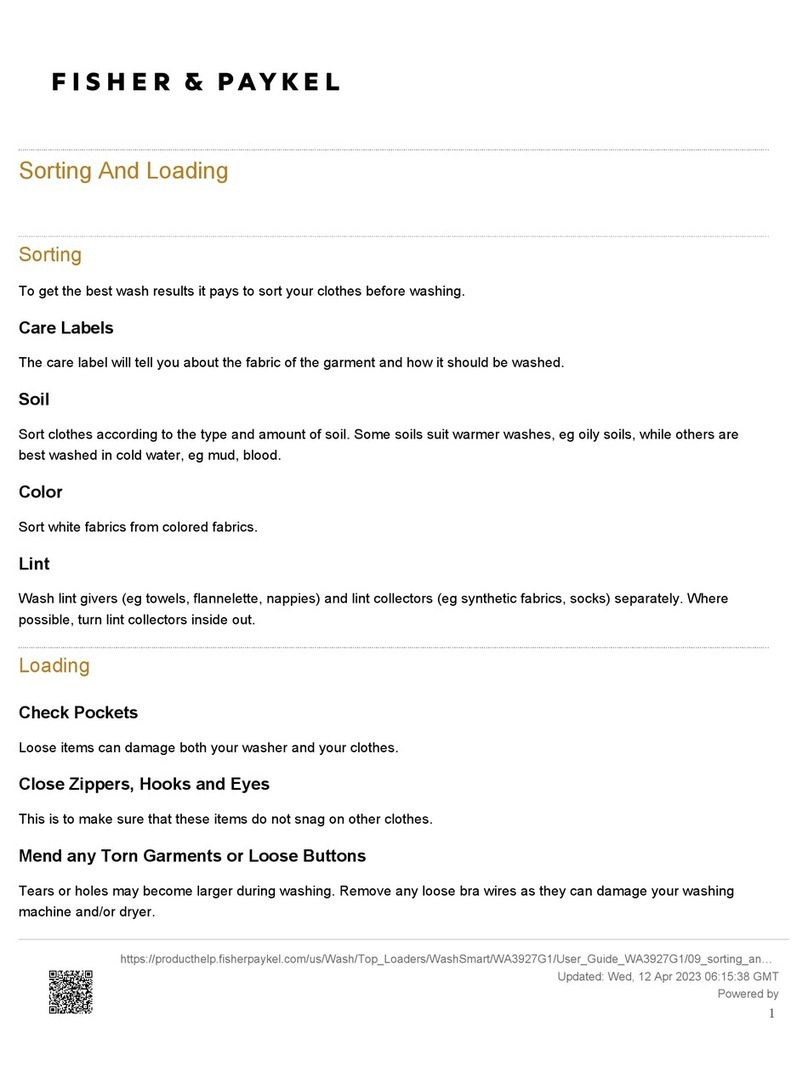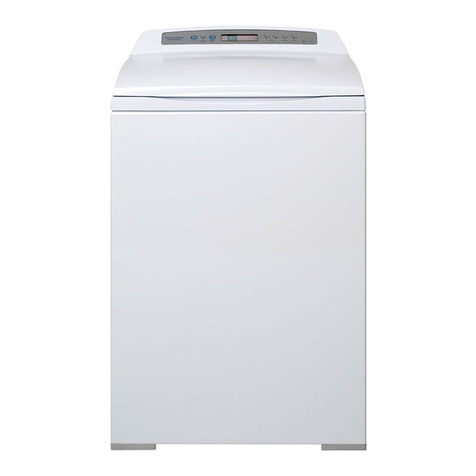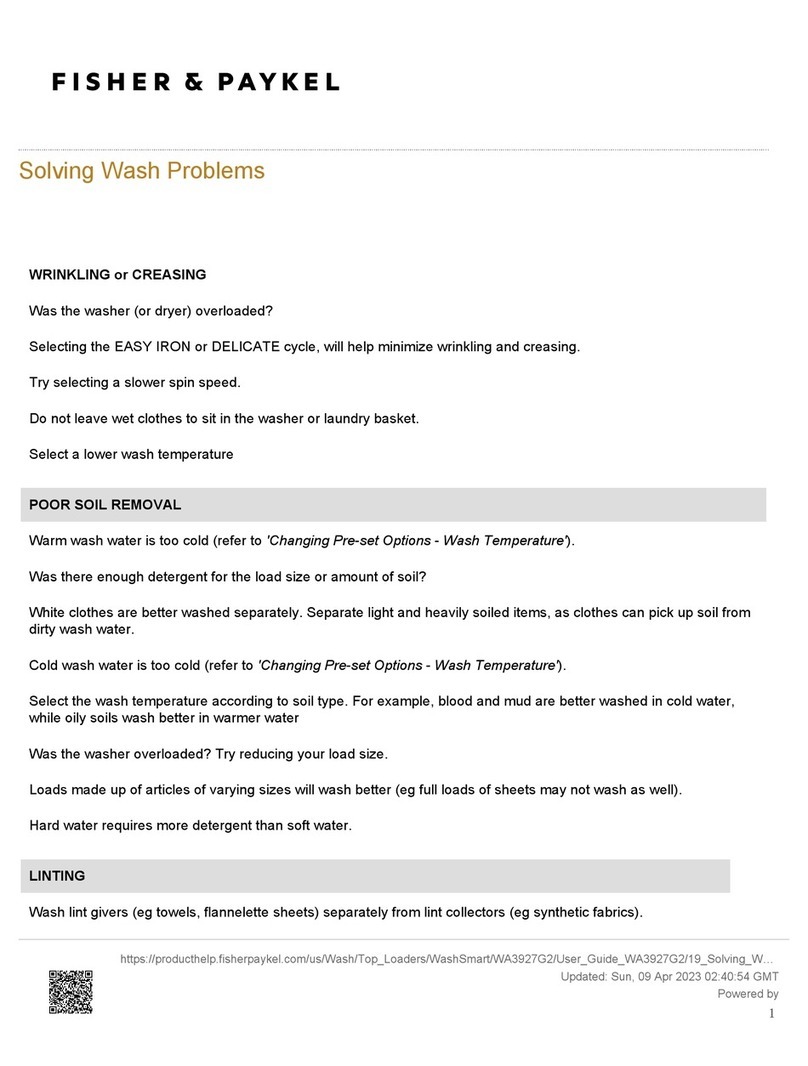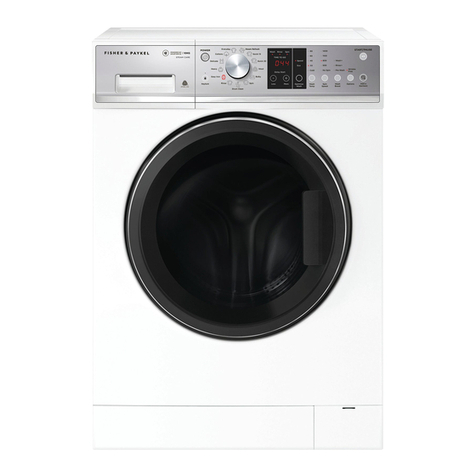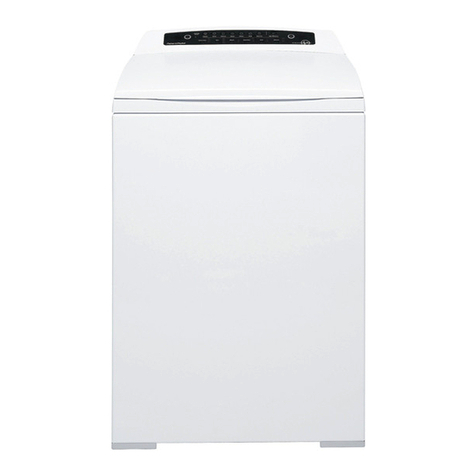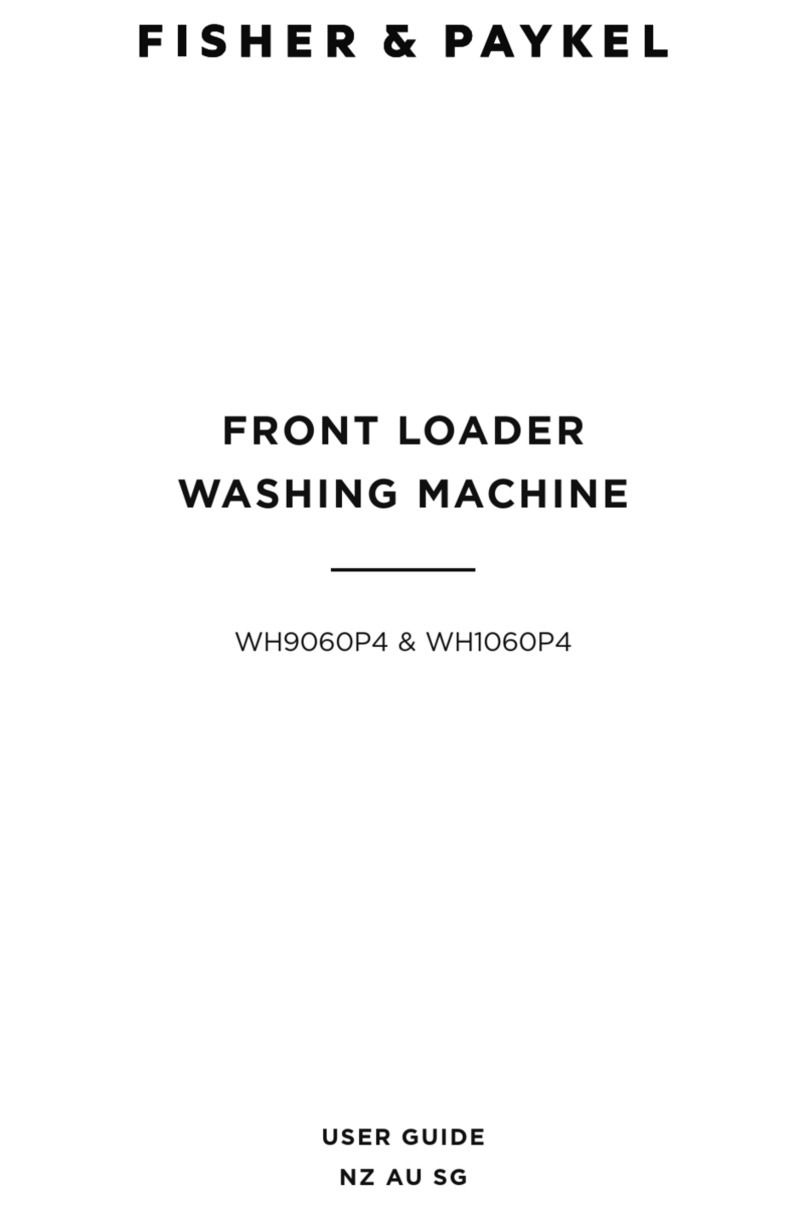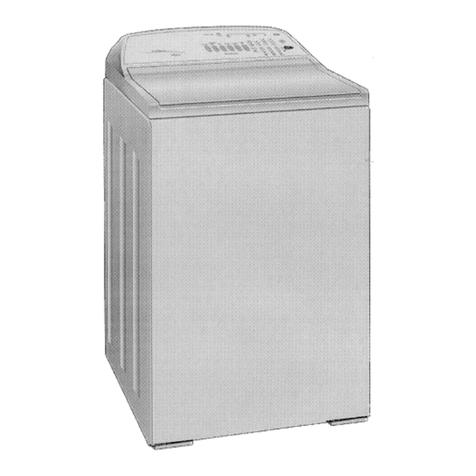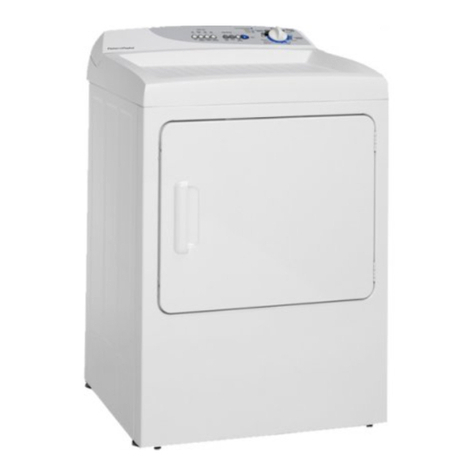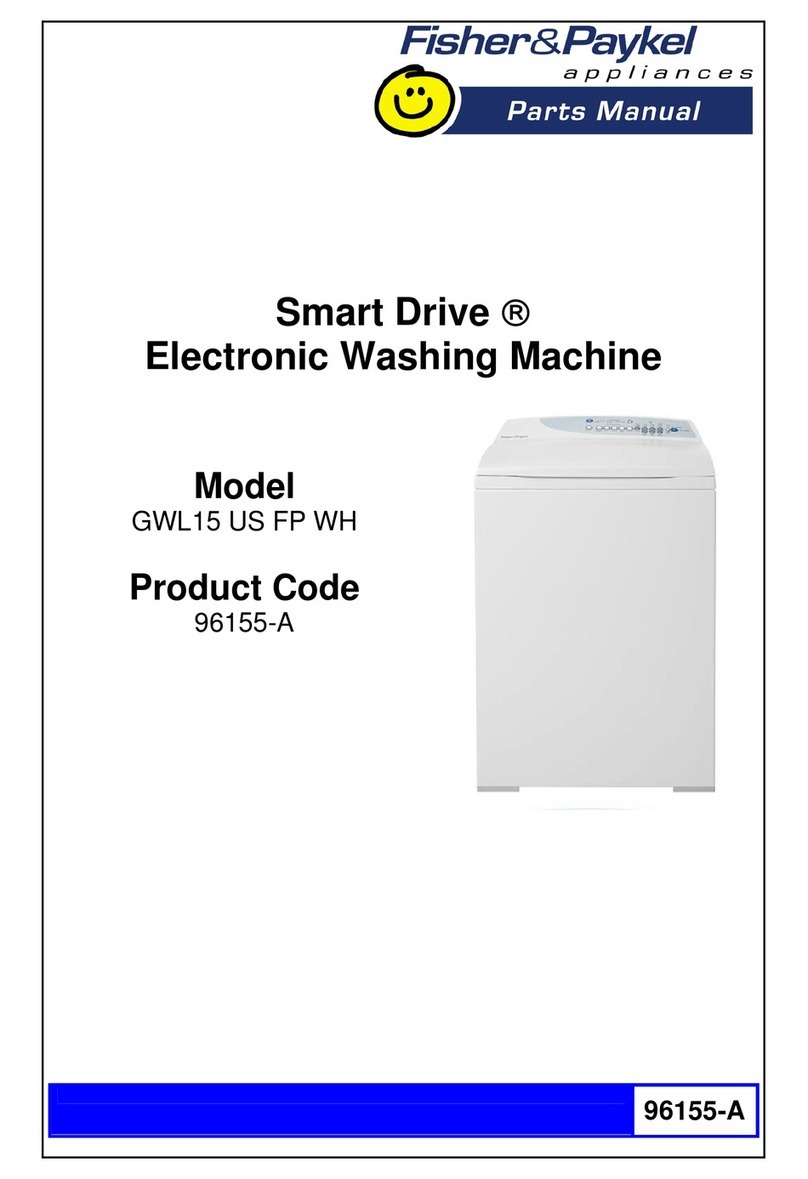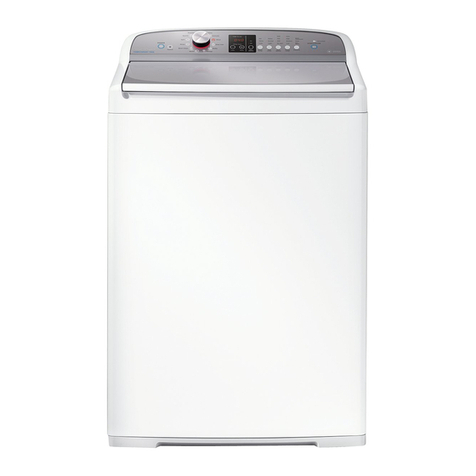
- 2 -
FLOATING BASKET
During spin, the agitator and the basket have to be
coupled together and turn as a single unit. In
agitate, the agitator and basket have to be free to
rotate independently.
At the base of the basket is a flotation chamber. As
the water level rises the basket will float. This
action disconnects a clutch between the agitator
and basket. The agitator and basket can now
move independently.
When the water is pumped out, the basket sinks
down and re-engages, allowing the agitator and
basket to turn as one unit.
DRAIN PUMP
The drain pump motor is attached to the base of
the tub. The pump housing is an integral part of
the tub. The pump can be accessed from the top, if
the agitator and basket are removed, or from
underneath the machine.
DIVERTER VALVE
A diverter valve is located underneath the tub. This
directs the tub water to the drain hose or to the re-
circulation hose. The valve is on whilst the
machine is filling and re-circulating the wash water.
It is also turned on briefly at the beginning of the
rinse cycle to allow the re-circulation hose to
empty.
LIDLOCK
This machine has a lidlock that will lock the lid
closed when the machine is spinning. If the lid is
open at the beginning of rinse or spin, the machine
will stop and sound a warning tune. See user
warnings
OUT OF BALANCE SWITCH
A lever and switch is located in the right rear corner
of the topdeck. If the switch is activated the
machine will stop and sound a warning. (See User
Faults).
LINT REMOVAL SYSTEM
As a result of the agitator action, lint and wash
water is drawn into the agitator stem and down to
the base, where they are directed into the cavity
between the basket and tub. The holes in the
basket allow the wash water to flow back into the
basket but prevent the lint from following. Lint is
carried out with the waste water.
OPTION ADJUSTMENT MODE
The washer can be adjusted to operate under a
number of different conditions. The feature is
called OPTION ADJUSTMENT MODE. Features
that can be controlled include:
•Rinse Options
•Number of End of Cycle warning beeps
•Automatic Out of Balance recovery
•Automatic water level adjustment
•Softener rinse volume adjustment.
•(See Use & Care Manual for details)
USER FAULTS
Incorrect installation or operation can cause user
faults. The washer can detect these and alert the
operator by a musical series of beeps and either
displaying a warning on the screen or flashing an
LED. These are also listed in the Use & Care
Manual.
Out Of Balance
IWL12 - “My Load is OUT OF BALANCE”
GWL11 – First rinse LED or Final Spin LED is
flashing
1. Ensure the machine is stationary and
manually redistribute the load.
2. Check the machine is level.
No Hot Water
IWL12 - “I am not getting any HOT WATER”
GWL11 - Hot LED flashing
Hot water supply is not hot enough to maintain the
temperature you have selected.
1. Select a lower wash temperature.
2.Inlet hose screens may be blocked.
3. There may be a kink in the hose.
4. Hot tap has not been turned on.
5. Inlet hoses connected to the wrong faucets.
No Cold Water
IWL12 - “I am not getting any COLD WATER”
GWL11 - Cold LED flashing
1. Cold tap hasn’t been turned on.
2. Inlet hose screens may be blocked.
3. There may be a kink in the hose.
4. Inlet hoses connected to the wrong faucets.
5. Cold water exceeds recommended limits.
6. The flow rate of water may be too slow.
No Faucets
IWL12 - “I am not getting any WATER”
GWL11 - Cold and Hot LEDs flashing
1. The faucets haven’t been turned on.
2. Inlet hose screens may be blocked.
3. The hoses may be kinked.
4. The drain hose is too low or the drain hose is
pushed into the standpipe too far and the
water is siphoning out of the machine.
5. The flow rate of the water is too slow.
Overloaded
IWL12 - “I am OVERLOADED”
GWL11 - High water LED flashing
The machine is overloaded and cannot agitate.
1. Begin removing items until the remaining
ones can move freely, or select a higher
water level.
2. Check the machine is not syphoning
Too Much Detergent
IWL12 - “I have TOO MANY SUDS”
GWL11 - High water LED flashing
The machine has a suds build up. (Too much
detergent may have been used for the amount of
soil in the load).
1. Wait for suds to dissolve (about 20 minutes).
2. Rinse clothes using a deep rinse.
Lid Open
IWL12 - “I can’t LOCK THE LID”
GWL11 - Lidlock LED flashing
Make sure the lid is closed.
Press START PAUSE.
MACHINE SIZE SETTING
The machine size must be set into the machine
memory if a Motor Controller or Display Module has
been changed.
To set the size:
1. Turn the power on at the power point and off
at the console.
2. IWL12 - Press and hold the FABRIC CARE
button, then press the POWER button. This
will present a set of options in the LCD
screen. The LCD screen has within it a
number of options. Push the Adjust button to
highlight the 650mm (L) machine size.
Pushing the POWER button will lock the size
into the module’s memory.
GWL11 – Press and hold the WASH TEMP
UP button then press the POWER button.
Press the SPIN SPEED UP button (the HOLD
LED should be on.)
3. Press the POWER button to return to normal
operation.
IF A FAILURE OCCURS
Most failures are diagnosed by the Diagnostic
System. If a fault is detected, the operation of the
machine will stop. A fault code will either appear on
the LCD display screen, or by displaying a series of
wash progress LED’s. A continuous beeping sound
will also occur. If this happens:
1. Remove the plug from the wall outlet for at
least one-minute.
2. Plug in and start the machine. If the
condition recurs, use the Diagnostic Mode to
determine the cause.
DIAGNOSTIC MODE
The washers are fitted with a diagnostic system
designed to help test the machine and obtain
information that will assist in locating a fault. The
Diagnostic mode also incorporates tests for both
the drain pump and the water valves.
To Select DIAGNOSTIC MODE
1. Turn the power on at the power point and off
at the console.
2. IWL12 - Press and hold the LIFECYCLES
button and then the POWER button. The
machine will give 2 short beeps and the LCD
screen will go blank. Then press the
LIFECYCLES button again.
GWL11 – Press and Hold the WASH TEMP
DOWN button and them press the POWER
button.
IWL12 One of three screens will now appear:
•Warning Status
•Machine Status
•Fault Status
You can scroll between these screens using the
options up and down buttons.
The Warning Status screen will display the last
USER WARNING FAULT that occurred and will
show at what part of the cycle it occurred.
The User Warning Faults are as follows:
- No Faucets
-Overloaded
- Out Of Balance
- Over Suds or water still in the machine
during spin
- No Hot Water
- No Cold Water
- Agitate Overloaded
